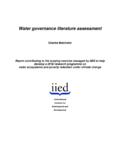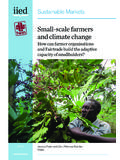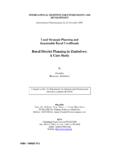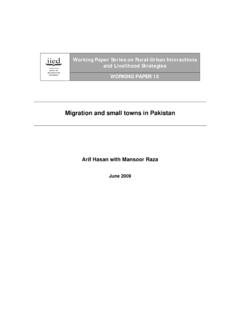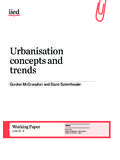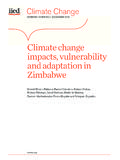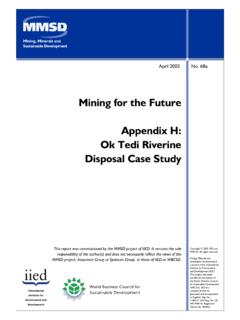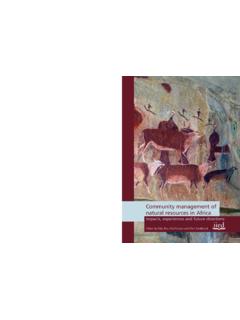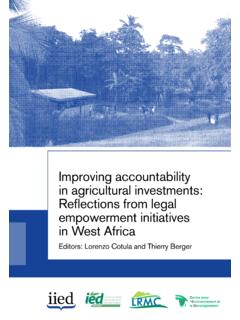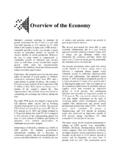Transcription of Editorial The links between urban and rural …
1 Editorial The links between urban and rural development Cecilia Tacoli I. INTRODUCTION tion. There are also significant synergies between many rural and urban interests. THIS IS THE second issue of Environment Some factors can be generalized as having a key &Urbanization focusing on rural urban linkages. role in the increase in the scale of rural urban link- The first, which came out in 1998, described the ages. Decreasing incomes from farming, especially reliance of many low-income households on both for small-scale producers who, because of a lack rural -based and urban -based resources in of land, water or capital, are unable to intensify constructing their livelihoods. But the majority of and switch to higher value crops, means that the papers also underlined the fact that this strad- increasing numbers of rural residents engage in dling of the rural urban divide is usually ignored non-farm activities that are often located in urban by policy makers, and that the rigid division centres.
2 For those who continue farming, direct between rural and urban on the part of access to markets is essential in the wake of the sectoral strategies actually makes life more diffi- demise of parastatal marketing boards and cult for low-income groups. markets are also usually located in urban centres. The papers in this issue show many reasons Better access to markets can increase farming why it has become even less realistic for develop- incomes and encourage shifts to higher value ment specialists to separate into rural and urban crops or livestock. Population growth and distri- camps. The notion of a divide has become a bution patterns affect the availability of good agri- misleading metaphor, one that oversimplifies and cultural land and can contribute to rural residents even distorts the realities. As these papers demon- moving out of farming. With the expansion of strate, the linkages and interactions have become urban centres, land uses change from agricultural an ever more intensive and important component to residential and industrial, and in the peri- urban of livelihoods and production systems in many interface these processes go hand in hand with areas forming not so much a bridge over a divide transformations in the livelihoods of different as a complex web of connections in a landscape groups with the poorest often losing out.
3 Where much is neither urban nor rural , but Perhaps more significant than the absolute has features of both, especially in the areas around availability of natural resources in relation to urban centres or along the roads out of such population numbers and density are the mecha- centres (what can be termed the peri- urban inter- nisms which regulate access to, and management face). In addition, much of the rural population of, such resources. These include land tenure depends on urban centres for access to secondary systems and the role of local government in nego- schools, post and telephones, credit, agricultural tiating the priorities of different users and in extension services, farm equipment, hospitals and providing a regulatory framework which safe- government services. Of course, there are still guards the needs of the most vulnerable groups conflicts between rural and urban interests. But while, at the same time, making provision for the there are also conflicts between many urban inter- requirements of economic and population growth.
4 Ests and the needs of most of the urban popula- Such mechanisms continue to call for attention, to This issue was developed in partnership with the development Planning Unit (DPU), University College London. Many of the papers in this issue were presented at the DPU Conference on rural - urban Encounters: Managing the Environment of the Peri- urban Interface held in London in Novem- ber 2001. Particular thanks are due to Julio D vila, Michael Mattingly and Patrick McAlpine for helping develop this issue. The development Planning Unit also manages a research programme on the peri- urban interface; for more details see Environment&Urbanization Vol 15 No 1 April 2003 3. Editorial make it possible for more vulnerable groups to based producers to urban markets, both for local successfully plot a course through this increas- consumers and for forwarding to regional, ingly complex landscape . national and international markets; and, in the But there has also been progress in recognizing opposite direction, flows of manufactured and and responding to this complexity.
5 Many of the imported goods from urban centres to rural papers in this issue draw attention to the growing settlements. They also include flows of people intensification of the links in the rural urban moving between rural and urban settlements, continuum, describing initiatives which respond to either commuting on a regular basis, for occa- these links and the progress made in understand- sional visits to urban -based services and admin- ing the specific characteristics of peri- urban areas. istrative centres, or migrating temporarily or However, whilst there is greater recognition of the permanently. Flows of information between rural spatial (and inter-sectoral) dimension of the ways and urban areas include information on market in which different groups make a living, and its mechanisms from price fluctuations to implications for poverty reduction, many papers consumer preferences and information on also underline the difficulties that low-income employment opportunities for potential migrants.
6 Groups face in dealing with government institu- Financial flows include, primarily, remittances tions. For example, the paper by van den Berg, van from migrants to relatives and communities in Wijk and Pham Van Hoi describes how rural sending areas, and transfers such as pensions to communities around Hanoi, Vietnam's capital, are migrants returning to their rural homes, and also a key source of fresh food such as fish, pork and investments and credit from urban -based institu- vegetables for the city's residents. As the city tions. expands, many farmers lose their land to Hanoi's These spatial flows overlap with interlinkages urban development agency's residential or between sectors both at the household level and commercial developments, but they rarely get at the level of local economies. They include back- compensation reflecting the real value of the land; ward and forward linkages between agriculture at the same time, local governments in the rural and manufacturing and services, such as produc- districts around Hanoi lose control of land under tion inputs and the processing of agricultural raw their jurisdiction to the city government whenever materials.
7 Most urban centres, especially small this is needed for urban purposes. Comparable and intermediate ones, rely on broad-based processes around Manila, although within a very demand for basic goods and services from different context, were described by Kelly in the surrounding populations to develop their second- 1998 issue.(1) Other initiatives, such as the farmers' ary and tertiary sectors. Overall, synergy between markets in Tamil Nadu, South India, show agricultural production and urban -based enter- increased concern with supporting better links prises is often key to the development of more between rural producers and urban consumers. vibrant local economies and, on a wider level, to The paper by Rengasamy et al. shows that these less unequal and more pro-poor regional farmers' markets did provide benefits for a number economic growth.(2). of small and marginal farmers and also for mobile Whilst, to some extent, these flows and link- vendors and low-income consumers but greater ages exist between all rural and urban areas, their attention to the specific needs and circumstances scale and strength are determined by the nature of the most vulnerable groups, and their more of economic, social and cultural transformations.
8 Active involvement in planning and implementing These can be divided further into three broad this initiative, would have resulted in greater bene- categories: the global, the national and the local fits for producers, traders and consumers alike. levels. At the global level, the liberalization of trade and production has changed or reshaped II. HOW rural urban rural urban linkages in most regions. The INTERACTIONS ARE increased availability of imported manufactured INTERLINKED WITH ECONOMIC, and processed goods affects consumption SOCIAL AND CULTURAL patterns in both rural and urban settlements; but TRANSFORMATIONS since these are often cheaper than locally produced goods, local manufacturers and proces- rural urban LINKAGES include flows of sors can be negatively affected. This is especially agricultural and other commodities from rural - the case for small-scale enterprises using tradi- 4 Environment&Urbanization Vol 15 No 1 April 2003. Editorial tional or limited technology and often employing At the national level, macroeconomic policies women, for example in traditional cloth weaving linked to reform and adjustment have an impact in southeast Nigeria and vegetable oil production on rural urban linkages.
9 The sharp reduction in in Tanzania, as described in the paper by Bah et subsidies to agricultural inputs has affected the al. In the agricultural sector, trade in export crops incomes of small-scale, under-capitalized farmers is largely controlled by international traders who in most nations, whilst the retrenchment of tend to by-pass local urban centres for processing workers in the formal sector has deepened finan- and marketing, and who also retain much of the cial insecurity in the urban centres. At the same added value and do not necessarily invest it in the time, the increase in the cost of food and the intro- producing region or even nation. Moreover, strin- duction of user fees for education and health serv- gent quality controls and quantity requirements, ices has forced many households to seek cash linked to demand in high-income nations and the incomes through employment diversification . preference of larger retailers there, often exclude including non-farm occupations for rural resi- small-scale farmers who do not have the financial dents, often located in urban centres migration capital to purchase the necessary inputs.
10 At the and urban agriculture. same time, the increase in the number of interna- The increased emphasis on producers' direct tional tourist resorts and the establishment of access to markets, following the dismantling of export processing zones have created new, albeit marketing boards which used to be the main limited, areas of employment that, in many cases, outlet for small agricultural producers, has rely on migrant workers, especially women. strengthened the links with urban centres, where An often overlooked aspect of globalization is local markets and links to wider regional and its impact on social and cultural values. national marketing systems are located. This is Increased access to information on different and not without problems, however, as inadequate often distant places has an important role in infrastructure and storage and processing facili- younger generations' desire to migrate to expe- ties can hamper increased returns for producers. rience the wider world, and to move out of Whilst adjustment policies and economic farming in favour of more modern types of reform have had a generally negative impact on employment in services and albeit less so low-income groups in both rural and urban areas, manufacturing.
